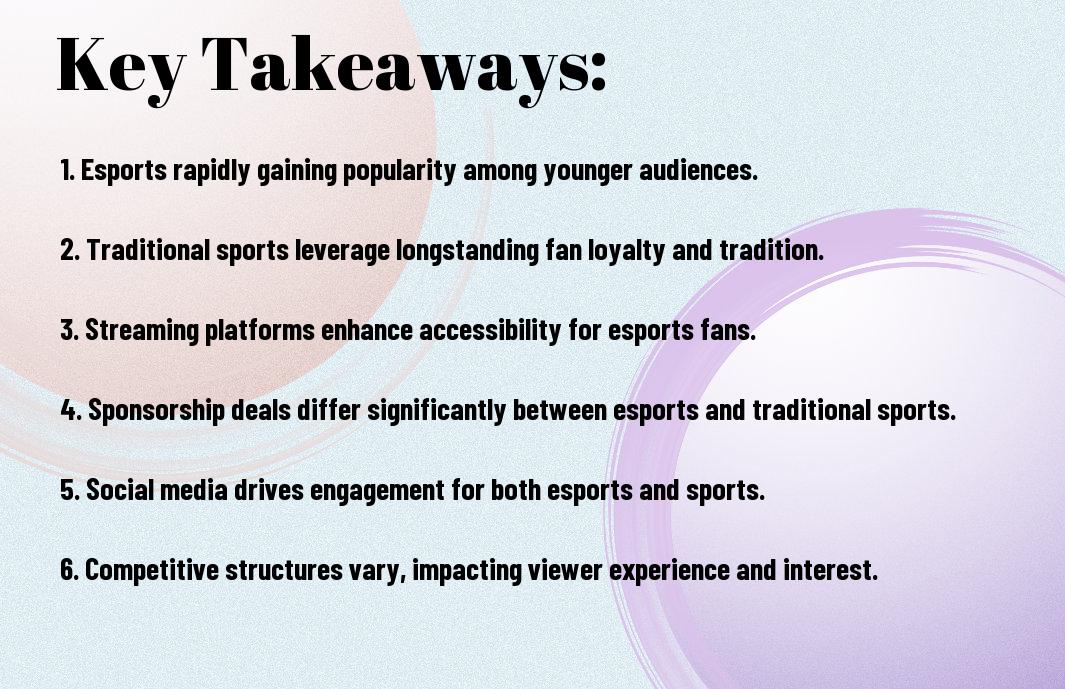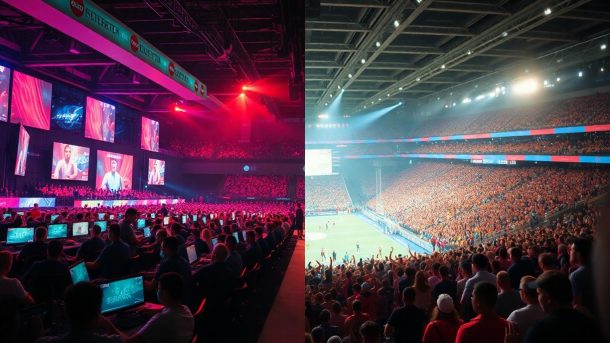As you consider the evolving landscape of sports entertainment, you’re likely wondering which type of competition will capture your attention: esports or traditional sports. You’re not alone in this dilemma, as millions of viewers are making the same choice. Your preferences will play a significant role in shaping the future of the sports industry, with both esports and traditional sports vying for your loyalty and viewership. You’ll need to decide which one resonates with you more.
Key Takeaways:
- Esports and traditional sports are competing for the attention of viewers, with both offering unique experiences and attractions that cater to different demographics and interests.
- The global esports audience is growing rapidly, with estimates suggesting it will surpass 500 million viewers by 2024, presenting a significant challenge to traditional sports in terms of viewer engagement.
- Traditional sports have a long history and established fan base, but esports offers a more immersive and interactive experience, with live streaming and online engagement playing a key role in its popularity.
- The demographics of esports and traditional sports fans differ, with esports skewing towards a younger, more tech-savvy audience, while traditional sports tend to attract an older, more traditional viewer base.
- Esports offers a range of new and innovative sponsorship opportunities, including in-game advertising and product placements, which are attracting brands looking to reach a younger audience.
- The lines between esports and traditional sports are becoming increasingly blurred, with many traditional sports teams and leagues investing in esports and vice versa, creating new opportunities for collaboration and growth.
- The battle for viewer attention between esports and traditional sports will likely lead to increased innovation and investment in both industries, ultimately benefiting fans and driving growth in the global sports and entertainment market.
The Rise of Digital Competition
While the world of sports has traditionally been dominated by physical activities, you are now witnessing a shift towards digital competition, with esports gaining popularity at an unprecedented rate, captivating your attention and changing the way you consume sports.
Evolution of Esports
Among the key factors contributing to the growth of esports, you will find advances in technology, increased accessibility, and a growing community of enthusiasts, all of which have helped to establish esports as a viable alternative to traditional sports, offering you a new way to engage with competitive gaming.
Traditional Sports Legacy
With a rich history and a massive following, traditional sports have long been the dominant force in the world of athletics, and as you consider the impact of esports, you should also acknowledge the enduring appeal of sports like football, basketball, and baseball, which continue to attract vast audiences and inspire loyalty in their fans.
For instance, you can look at the way traditional sports have evolved over time, incorporating new technologies and innovations to enhance the fan experience, from high-definition broadcasts to social media engagement, and you will see that these sports are not standing still, but rather adapting to the changing landscape and competing with esports for your attention.


Audience Demographics
There’s a notable difference in the audience demographics of esports and traditional sports, which affects your viewing experience and engagement with these events.
Digital Native Appeal
With the rise of online platforms, you’ll find that esports attracts a younger audience, born and raised in the digital age, who are more comfortable with the fast-paced and tech-savvy nature of esports.
Traditional Sports Fan Base
Digitally, you may think traditional sports have an older fan base, but they also have a strong following across various age groups, with many fans loyal to their favorite teams and players.
Consequently, as you explore the world of traditional sports, you’ll discover that their fan base is often deeply rooted in local communities, with fans attending live events and participating in fantasy leagues, creating a sense of camaraderie and shared experience that is unique to traditional sports.
Revenue Streams
Despite the differences in their nature, both esports and traditional sports generate significant revenue. You will notice that their revenue streams vary, with esports relying on digital platforms and traditional sports on ticket sales and broadcasting rights.
Digital Monetization Models
Reaping financial benefits from esports is largely dependent on digital monetization models, which you can leverage through online advertising, sponsorships, and subscription-based services, allowing you to tap into a vast and engaged audience.
Conventional Sports Economics
Modeling your revenue strategy after traditional sports can be beneficial, as you will see that their economics are well-established, with a focus on broadcasting rights, merchandise sales, and ticketing, providing you with a framework to understand the financial aspects of the industry.
Considering the conventional sports economics, you can gain a deeper understanding of how traditional sports have maintained their financial stability over the years. You will observe that their revenue models are often based on long-term contracts, licensing agreements, and strategic partnerships, which provide a stable source of income, allowing you to apply these principles to your own esports ventures and make informed decisions about your revenue strategy.
Media Coverage and Broadcasting
Your viewing habits are changing, and the way you consume sports is no exception. The rise of esports has led to a shift in media coverage, with more emphasis on online streaming and broadcasting.
Streaming Platforms
Along with the growth of esports, platforms like Twitch have become increasingly popular, allowing you to watch your favorite teams and players compete in real-time, with interactive features that enhance your viewing experience.
Traditional Broadcasting Networks
About the same time, traditional broadcasting networks have started to take notice of esports, with some even dedicating entire channels to esports coverage, giving you more options to watch your favorite esports events.
Due to the increasing popularity of esports, traditional broadcasting networks are now investing more in esports coverage, providing you with high-quality production and commentary, making your viewing experience more enjoyable and immersive, and allowing you to follow your favorite esports teams and players more easily.
Athlete Development
Now, as you consider the differences between esports and traditional sports, you can explore how athlete development varies between the two. You can learn more about Esports vs “Real” Sports and how it impacts your understanding of athlete development.
Digital Training Methods
Alongside traditional training, digital methods are becoming increasingly popular, allowing you to practice and improve your skills in a virtual environment, which can be beneficial for your esports career.
Physical Sports Training
Across various traditional sports, you will find that physical training is a key component, requiring you to develop your strength, endurance, and agility to compete at a high level.
The physical demands of traditional sports mean that you will need to focus on building your overall fitness, which can be time-consuming and may lead to injuries if not done properly, so you should consider seeking guidance from a professional coach or trainer to help you develop a safe and effective training plan.
Fan Engagement
After analyzing the landscape, you’ll find that esports and traditional sports have different approaches to fan engagement, as seen in the comparison of How the eSports Industry Fares Against Traditional Sports.
Virtual Community Building
The ease of online interaction allows you to connect with others worldwide, creating a vast and dedicated fan base.
Stadium Experience
An immersive experience awaits you in traditional sports stadiums, with cheering crowds and live commentary.
And as you attend a traditional sports event, you’ll notice the electric atmosphere, with fans dressed in their team’s colors, cheering and chanting together, creating an unforgettable experience that esports is now trying to replicate with its own live events and venues, allowing you to be part of a larger community.
Conclusion
Considering all points, you now have a clearer understanding of the esports vs traditional sports debate. As you weigh your options, your attention is the ultimate prize, and both industries are vying for it. You decide which type of sports to watch, and your choice will shape the future of entertainment. Your preferences will influence the growth and development of these industries, making your role a significant one in this battle for viewer attention.
FAQ
Q: What is the current state of the competition between esports and traditional sports for viewer attention?
A: The competition between esports and traditional sports for viewer attention is intensifying, with both industries experiencing significant growth in recent years. Esports, in particular, has seen a massive surge in popularity, with major tournaments and leagues drawing in millions of viewers worldwide. Traditional sports, however, still maintain a strong following and are adapting to the changing media landscape by incorporating new technologies and formats to engage with their audiences. As a result, the battle for viewer attention is becoming increasingly fierce, with both sides investing heavily in marketing, production, and distribution to capture the largest share of the audience.
Q: How do the demographics of esports and traditional sports audiences differ, and what implications does this have for their respective growth strategies?
A: The demographics of esports and traditional sports audiences differ significantly, with esports tend to skew towards a younger, more digitally-native audience, while traditional sports tend to attract an older, more established fan base. Esports audiences are also more likely to be male, although the gender gap is narrowing as the industry continues to grow and mature. In terms of implications, these demographic differences mean that esports organizations and traditional sports leagues must tailor their growth strategies to their respective audiences, with esports focusing on digital engagement and community-building, and traditional sports emphasizing storytelling, nostalgia, and in-person experiences. By understanding and catering to their unique demographics, both industries can effectively target and expand their audiences.
Q: What role will technology play in shaping the future of the esports and traditional sports industries, and how will they leverage innovations like streaming, virtual reality, and social media to attract and retain viewers?
A: Technology will play a pivotal role in shaping the future of both the esports and traditional sports industries, as innovations like streaming, virtual reality, and social media continue to transform the way fans consume and interact with sports content. Esports, in particular, is well-positioned to leverage these technologies, given its digital-native roots and existing expertise in streaming and online engagement. Traditional sports, meanwhile, are also investing heavily in technology, using data analytics, artificial intelligence, and immersive experiences to enhance the fan experience and attract new audiences. As these industries continue to evolve, we can expect to see even more innovative applications of technology, from virtual and augmented reality experiences to social media integrations and personalized streaming services, all designed to attract and retain viewers in an increasingly competitive media landscape.



